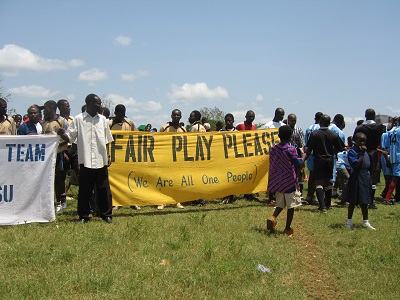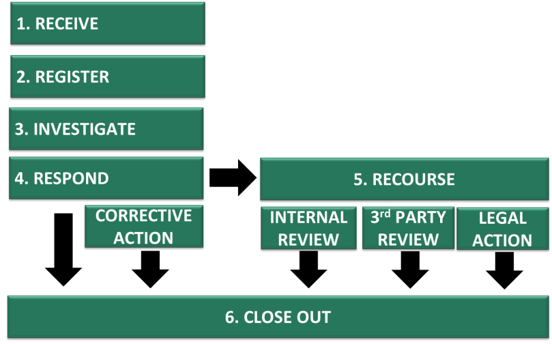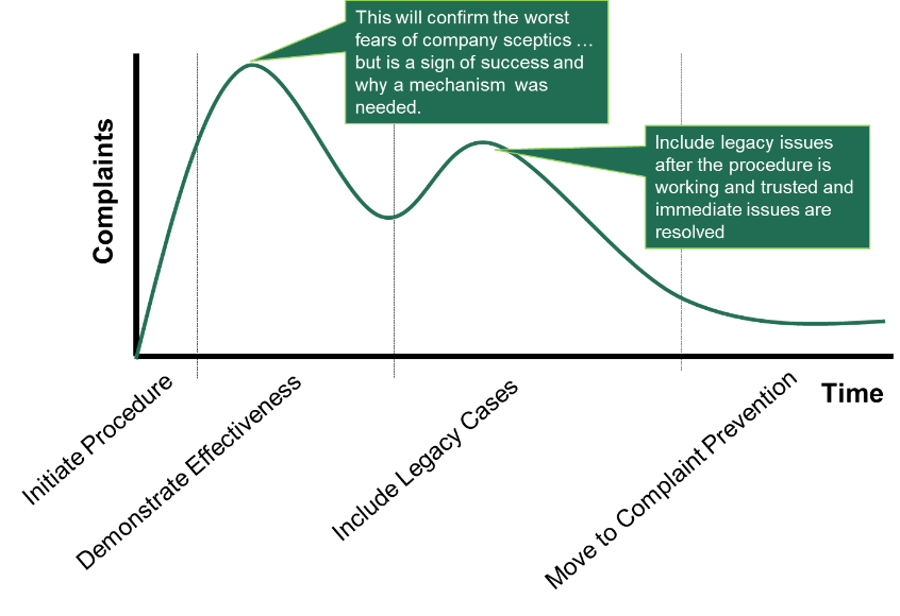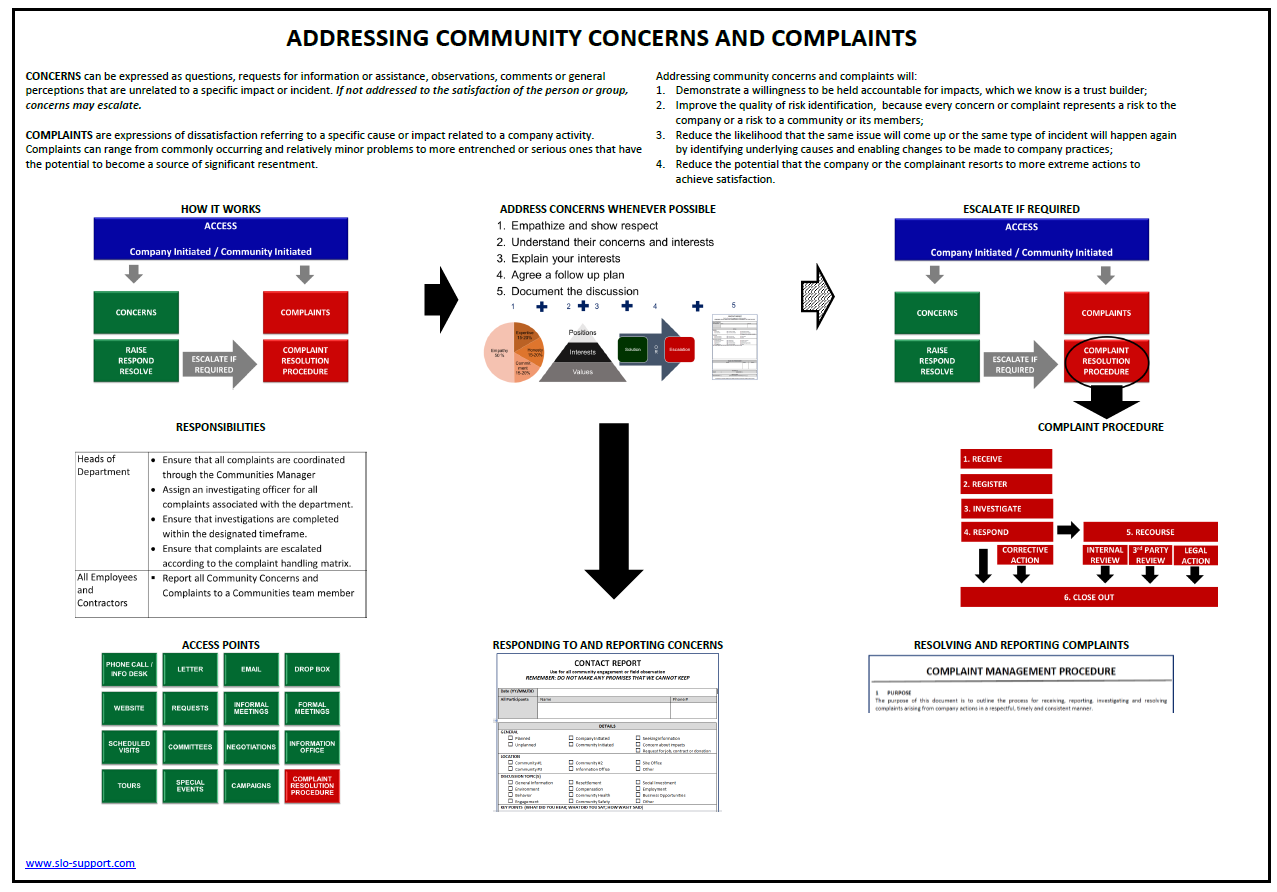Complaints are part of the landscape for any business. Taking complaints seriously and establishing a good complaint handling procedure is one of the most effective ways of dealing with local concerns. Implementing a simple, well-designed procedure demonstrates a willingness to take community members and their issues seriously. A good process can play a major part in building better relationships with local communities, will help with the early identification and resolution of concerns and will reduce the potential for unanswered questions to escalate into something more serious.
Addressing Complaints
-
Intro

-
Guide
- Identify regulatory and other requirements, understand how the local community works and what impacts the project has;
- Define boundaries and eligibility criteria – what the company will and will not do;
- Assign responsibilities for each step in the process;
- Think about modelling the oversight committee on the structure used for incident / accident investigations – the two processes are more similar than you might realise;
- Ensure you have a system in place to receive, record, and track every case and to create an institutional memory and that there is a budget so costs associated with each complaint can be estimated, allocated and paid;
- Test the system before going live and public to be sure all the pieces work; confirm that response times and targets are realistic and to establish what is and isn’t possible during the roll-out stage.
- Ensure all staff are trained. Everyone needs to have a basic knowledge of what is in the procedure and how it works. Ideally they would also have a general awareness of complaint resolution concepts;
- Develop a narrative and speaking points and use toolbox and other standing meetings to explain to employees, contractors and the security team;
- When the procedure has been tested and it is ready to go, using a structured campaign integrated with other consultation activities to formally announce the procedure will ensure widespread sharing of information and build an understanding of how the process works and what to expect.
- Number of Cases: New; Resolved; Closed; Abandoned;
- Number of Cases not acknowledged within the specified timeframe;
- Resolution time; Maximum; Mininimum; Target;
- Number of complaints grouped by Aspect; Location; Department / Contractor;
- Repeat grievances associated with the same Department / Contractor;
- Underlying causes.
Guide to Community Complaints
WHY COMMUNITY COMPLAINTS MATTER:
Complaints are part of the landscape for any business, and especially so for anyone operating close to communities. Although a complaint, by its very nature, requires dealing with dissatisfied and often unhappy people, taking complaints seriously and establishing a good complaints handling procedure is one of the most effective ways you can deal with local concerns. A well implemented procedure demonstrates a willingness to take community members and their issues seriously and has a major part to play in building better relationships with your local communities. It will also enable you to identify and resolve issues and concerns early which in turn will reduce the potential for complaints to escalate into litigation, protests, security incidents, or regulatory challenges. It will also bring your behaviour in to line with current international standards and broader societal expectations. While a good complaint handing process is an essential first step, your ultimate aim needs be making changes to the way you operate so that you avoid actions that lead to complaints.
WHAT TO DO:
HOW TO DO IT:
Develop a fit-for-purpose complaints procedure
Educate
Review Performance
Establish a small number of indicators to confirm you are on track and improving over time:
WHAT ELSE YOU CAN DO:
Complaint prevention: Local employment and local procurement are usually major sources of complaints. Good policies, effectively executed will go a long way towards preventing complaints.
Follow these six steps when resolving complaints:

Build on what you have: Managing complaints and managing incidents have many similarities so if you have a good incident procedure you could think about whether you can modify it to handle grievances rather than start from scratch.
Involve the Complainant: Ensuring the complainant understands the process, participates in the investigation process and plays a part in determining the solution will reduce the likelihood an agreement will not be reached.
Recourse: If the company response is unacceptable, the complainant must have the right to use other avenues to receive redress, including legal action. This must be made clear at the time that the complaint is registered and at the various decision points in the process. Good practice is for legal action to be used as a last resort, only to be considered when all other options have been exhausted, however the complainant is always free at any time to take legal action.
Roll Out and Operation: The immediate period following the roll out will be busy, as communities test out the process and old concerns (if any) are addressed. This initial period where the effectiveness of the mechanism is demonstrated is generally followed by a period of calm. At the point where the initial caseload of complaints has been addressed, legacy cases can be included, which will likely see a second, less intense, peak in complaint volume.

-
More Resources
- More actions for a stronger social licence
-

I've written before about ten must-do-actions for a stronger social licence. These come from personal experience working in company-community relations on mine sites in Africa. This new/different/alternative take on doing what matters comes from local communities, reflecting directly on their concerns for the well-being and development opportunities for individuals and the collective community...
- Mining and Community Complaints
-

What are we talking about here?
Taking complaints seriously and establishing a good complaint handling procedure is one of the most effective ways of dealing with local concerns. Implementing a simple, well-designed procedure demonstrates a willingness to take community members and their issues seriously. A good process can play a major part in building better relationships with local communities, will help with the early identification and resolution of concerns and will reduce the potential for unanswered questions to escalate into something more serious.
- Actions for a stronger social licence
-

Check-out the one-minute video before looking deeper into the need-to-do-actions to demonstrate the behaviour needed to establish trust and build relationships. Without trust and good relationships the likelihood of success (for the business generally and for community-facing activities in particular) is greatly reduced...
- Mining and Social Licence
-

Social Licence to Operate is a mining industry concept. The expression was first used by Canadian Jim Cooney in 1997. This was a decade after the landmark 1987 Brundtland Report and a few years after the concept of the triple-bottom-line was first described by John Elkington. Its use has now spread well beyond the mining industry and as has happened with triple-bottom-line and sustainable development, the term "social licence" has been interpreted and used in many ways. Licence to Operate is currently seen by many as one of the biggest risks to the mining and metals industry, just as it was back in the 1990’s when Jim Cooney coined the term...
- In the beginning...
-

My social licence journey began in 2005 when I went to Ghana as part of a team planning to build a new mine. I had been working on the studies and design work for the company's Ghana projects for five years so I was very familiar with the project but not particularly familiar with Ghana which I had visited only three times, two of those being very short project kick-off trips. I was also a complete community novice, with Ghana being my first overseas assignment so, perhaps not surprisingly, I made plenty of mistakes and I learned a lot. What follows is a bit of a look back on some of the processes we put in place and the results we saw in three important areas...
- CAO Grievance Mechanism Toolkit
-
An excellent practical guide for implementing complaint resolution mechanisms. Read the online publication: CAO Toolkit
- Complaints-Management-on-a-Page
-
An easy way to see at a glance how to set up a system to address community concerns, complaints and grievances.

- IFC Grievance Mechanisms Good Practice Guide
-
Having a trustworthy way to address community concerns and complaints is essential if you're serious about building and maintaining a good relationship with your local communities. Whether you are starting our or reviewing your current practices this guidance is as relevant and useful today as it was when it was published in 2009.
- William Ury: Getting Past No
-
William Ury, co-author of 'Getting to Yes', the go-to classic on negotiation walks through a five step process to use when the techniques for co-operative negotiation fail. Learn how you can:
- Stay cool under pressure
- Disarm angry adversaries and breakthrough resistance
- Stand up for yourself without provoking opposition
- Deal with underhanded and dirty tricks
- Find agreeable solutions
- Use power constructively to reach agreement
You can find (and buy) the book online.
- Zandvliet and Anderson: Getting It Right
-
This book has been written for corporate managers who are responsible for company operations in societies that are poor and politically unstable. Many such managers are frustrated with the situations they face. They try their best to run effective, profitable and beneficial operations that take account of the needs of all their stakeholders, including local surrounding communities. But, even with their best efforts, they encounter community dissatisfaction, unrest, opposition, and delays and, worse yet, threats and violence. Why does this happen?
I was fortunate to have the opportunity to work with Luc while I was feeling my way during my early days in Ghana and am forever thankful for the lesson (obvious with the benefit of hindsight) that resource development by default creates tension and conflict, and that it is how companies approach conflict – as an opportunity or as a threat – that shapes the ongoing relationship between company and community. Some of the ideas in the book have been particularly sticky:
- Relationships matter – at a personal and business level this seems a no-brainer but sometimes the connection seems to get lost when it comes to communities
- Company impacts are never neutral – they can be negative or positive but from the time a company starts work on-the-ground it starts to create change
- People everywhere get annoyed about the same issues – this one gave me a lot of comfort that I could be confident applying the ideas to my particular circumstances plus, the issues are not complicated – behaving appropriately, taking responsibility for impacts and fair distribution of benefits are the keys
- Relationships require ongoing effort – again not really earth-shattering news, so it is somewhat surprising how often it happens that over time we take things for granted and it takes a nasty wake-up call to show us how far we’ve gone off the rails
- Company actions shape the nature of relationships – this last one relates back to the third point, because the reality is that the three issues that most influence a relationship - impacts, benefits and behaviour – are all company-initiated actions, and it is totally within the company’s control to determine what it is going to do and how it is going to act
You can find (and buy) the book online.